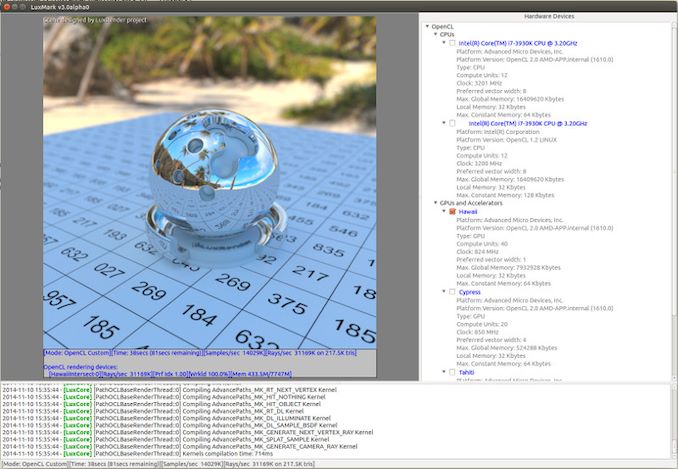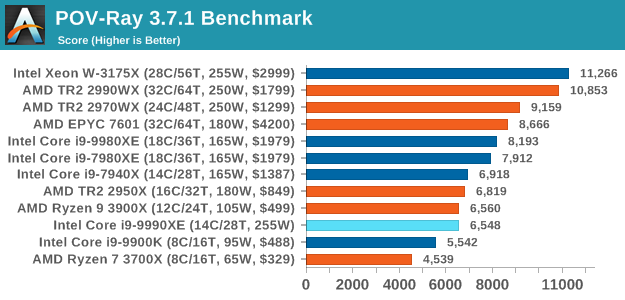The Intel Core i9-9990XE Review: All 14 Cores at 5.0 GHz
by Dr. Ian Cutress on October 28, 2019 10:00 AM ESTCPU Performance: Rendering Tests
Rendering is often a key target for processor workloads, lending itself to a professional environment. It comes in different formats as well, from 3D rendering through rasterization, such as games, or by ray tracing, and invokes the ability of the software to manage meshes, textures, collisions, aliasing, physics (in animations), and discarding unnecessary work. Most renderers offer CPU code paths, while a few use GPUs and select environments use FPGAs or dedicated ASICs. For big studios however, CPUs are still the hardware of choice.
All of our benchmark results can also be found in our benchmark engine, Bench.
Blender 2.79b: 3D Creation Suite
A high profile rendering tool, Blender is open-source allowing for massive amounts of configurability, and is used by a number of high-profile animation studios worldwide. The organization recently released a Blender benchmark package, a couple of weeks after we had narrowed our Blender test for our new suite, however their test can take over an hour. For our results, we run one of the sub-tests in that suite through the command line - a standard ‘bmw27’ scene in CPU only mode, and measure the time to complete the render.
Blender can be downloaded at https://www.blender.org/download/

Blender can take advantage of more cores, and whule the frequency of the 9990XE helps compared to the 7940X, it isn't enough to overtake 18-core hardware.
LuxMark v3.1: LuxRender via Different Code Paths
As stated at the top, there are many different ways to process rendering data: CPU, GPU, Accelerator, and others. On top of that, there are many frameworks and APIs in which to program, depending on how the software will be used. LuxMark, a benchmark developed using the LuxRender engine, offers several different scenes and APIs.

Taken from the Linux Version of LuxMark
In our test, we run the simple ‘Ball’ scene on both the C++ and OpenCL code paths, but in CPU mode. This scene starts with a rough render and slowly improves the quality over two minutes, giving a final result in what is essentially an average ‘kilorays per second’.

We see a slight regression in performance here compared to the 7940X, which is interesting. I wonder if that 2.4 GHz fixed mesh is a limiting factor.
POV-Ray 3.7.1: Ray Tracing
The Persistence of Vision ray tracing engine is another well-known benchmarking tool, which was in a state of relative hibernation until AMD released its Zen processors, to which suddenly both Intel and AMD were submitting code to the main branch of the open source project. For our test, we use the built-in benchmark for all-cores, called from the command line.
POV-Ray can be downloaded from http://www.povray.org/











145 Comments
View All Comments
Supercell99 - Monday, October 28, 2019 - link
The democrats have banned LN2 in New York as they have deemed it a climate pollutant.xrror - Monday, October 28, 2019 - link
No they haven't you republican jackass, the Earth's atmosphere is 78% nitrogen.eek2121 - Monday, October 28, 2019 - link
Because after a while, the system breaks down under LN2 cooling. There is such a thing as silicon being too cold, you know. Google intel cold bug, for example.ravyne - Monday, October 28, 2019 - link
Have you seen LN2 cooling? It's not really practical for prolonged use -- you have to keep the LN2 flowing, you have to vent the gasses of the expended LN2, you have to resupply the LN2 somehow.But you're missing the most important constraint of all for high-frequency trading, which is the reason they're building this processor into just 1 rack unit -- these machines aren't running on some remote data center, they're running in a network closet or very small data center probably just a floor or two away from a major stock exchange, in the same building. There is only so much space to be had. The space that's available is generally auctioned and can run well into 5-figures per month for a single rack unit. That's why they're building the exotic 1U liquid cooling in the first place, it'd be much easier to cool in even 2 units (there's even off-the-shelf radiators, then).
edzieba - Thursday, October 31, 2019 - link
These machines are installed in exchange-owned and managed datacentres. "No LN2" as a rule would scupper that concept from the start, but even if it were allowed then you still have the problem of daily shipments of LN2 into a metropolitan centre, failover if a delivery is missed, dealing with large volumes of N2 gas generated in a city centre, etc. Just a logistical nightmare in general.eek2121 - Monday, October 28, 2019 - link
It's impossible to cool a system 24/7 with LN2.DixonSoftwareSolutions - Tuesday, October 29, 2019 - link
I think you probably could do something like that. You would want to run it on a beta system in parallel with your production system for a long time to make sure you had the 99.999999% uptime required. You would have to get pretty down and dirty to make it a 24/7 system. Probably a closed loop LN2 system, and I don't even know what kind of machine is required to condense from gas to liquid. You would also probably want heaters on the other components of the motherboard so that only the die was kept at the target low temp, and other components at the correct operating temp. And you would probably have to submerge the entire thing in some dielectric fluid like mineral oil to prevent condensation from building up. It would be expensive no doubt, but if (m/b)illions are on the line, then why not? Also, before embarking on something like this, you would want to make certain that you had tweaked every last bit of your software, both third party software settings and internally authored code, to minimize latency.willis936 - Monday, October 28, 2019 - link
Judging from your description I would argue that a traditional PC is a horrible choice for such a problem, given the money at stake. They should be spinning custom ASICs that have the network stack and logic all put together. Even going through a NIC across a PCIe bus and into main memory and back out again is burning thousands of nanoseconds.29a - Monday, October 28, 2019 - link
I'm also wondering why they don't create custom silicon for this.gsvelto - Monday, October 28, 2019 - link
They do, not all HFT trading houses use software running on COTS hardware. Depending on where you go you can find FPGAs and even ASICs. However, not all of them have the expertise to move to hardware solutions; many are tied to their internal sofware and as such they will invest in the fastest COTS hardware money can buy.